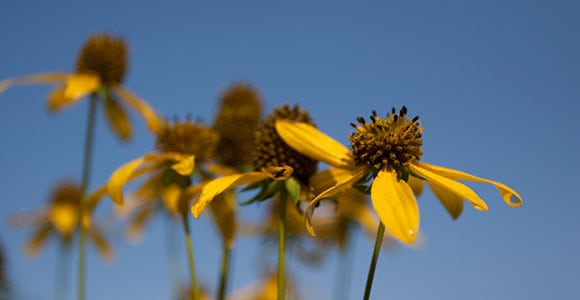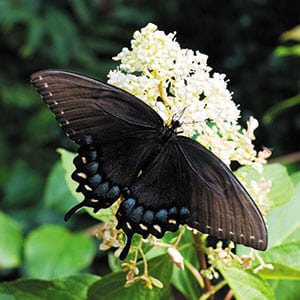
Spring is an ideal time for gardeners who love ornamental plants to plan for not only a bountiful show of blooms but also butterflies. That’s right — butterflies. Beginning in March and continuing until November or perhaps even December, Tennesseans can enjoy the tremendous natural beauty butterflies bring to any day spent outdoors — whether you’re hiking at a park, having a picnic or just gardening in your backyard.
These bright flits of kinetic color are enough to make even the most distracted backyard grower take notice. Of course, stray butterflies will fly into the garden just about any time during the spring and summer months, but when it comes to finding these beautiful winged insects in the landscape, the more the merrier! And the best way to bring in more butterflies is to simply offer them something to eat.

This can be done by serving up plants off of butterflies’ “Most Preferred List,” which is actually two lists because mature butterflies go for flowering, nectar-producing plants while their young — caterpillars — prefer to munch on plant foliage. Some butterflies are rather finicky eaters, but in general, there are plenty of plants around that will attract a large assortment of these beauties.
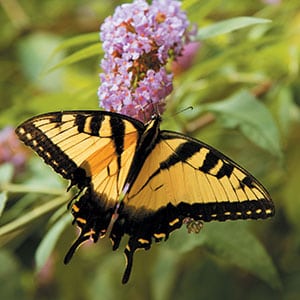
Nectar-loving adults are, of course, drawn to blooming plants. They seem to favor plants with red flowers first, followed by yellows, pinks, whites and purples. Also, they like blossoms that are flat-topped or clustered to allow them to land so they can feed while in park. Call it a fly-in diner, if you will.
And what specific kinds of flowers can be classified as butterfly magnets? Spring bloomers such as primrose, money plant, lilac, sweet William, rock cress and candytuft are great for attracting an assorted variety of adult butterflies at the beginning of the growing season.
In the summer, butterfly weed, bee balm, purple coneflower, butterfly bush, cosmos, daylilies, lantana, periwinkle, scabiosa, lavender, hydrangeas, yarrow, zinnias, phlox and verbena are some good choices to take over from the spring flowers and continue bringing butterflies into your garden.
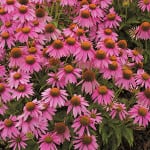
Butterflies will flock to fall flowers as well. Sedums, asters, salvias and swamp sunflowers are a few of the better late-blooming butterfly baits.
According to Rita Venable, president of the Middle Tennessee Chapter of the North American Butterfly Association (NABA), the types of plants to use in Tennessee vary by region.
“The best flowers to use in your garden are the ones best suited to your soil, moisture, temperatures and light levels,” the Middle Tennessee Electric Membership Corporation member says. “You wouldn’t plan the same garden in the Blue Ridge that you would plan along the Mississippi River. Study your region and your land.”
For those wishing to attract butterflies to their gardens, the Middle Tennessee Chapter of NABA has a gardening guide on its website, nabamidtn.org. There’s also a checklist of the types of butterflies you might see in Tennessee. For other regions of the state, you may want to check with local garden centers to see if they have anyone on staff who’s knowledgeable about how to attract butterflies in your area.
The blossoms of many native trees also double as desirable food for adult butterflies. Examples include tulip poplar, wild cherry, sassafras, persimmon, hackberry, redbud and pawpaw.

Even weeds will draw these winged beauties into your yard. Clover, henbit, morning glory and dandelion are all native “Volunteer” plants that pop up in the landscape and serve as sources for nectar.
The difference between a “weed” and a “native plant” often lies in its desirability in the garden. Many native plants are simply too pretty to not be included in cultivated gardens, and as a bonus, their nectar also attracts adult butterflies. Such indigenous lovelies include liatris, black-eyed Susan, cardinal flower, coreopsis, Indian blanket, ironweed, goldenrod and Joe-pye weed.
Butterfly larvae also like weeds. And since they munch on the foliage of these plants that many gardeners find undesirable, the caterpillars are actually helping with landscape maintenance. Some caterpillars chew on certain tree leaves as well. Elm, river birch, poplar, willow, dogwood and cherry trees seem to be tops on many of their dining lists. But as long as these leaf-eaters keep damage to a minimum, it is easy to live with their presence.
Interestingly, some butterfly caterpillars tend to be plant-specific — in other words, very picky about what kind of greenery they eat. A good example is butterfly weed. While this native perennial’s nectar is a big favorite for many different adult butterflies, its foliage is especially sought out by monarch larvae. This is also true for many of the other related plants in the milkweed family.

As a similar example, black swallowtail caterpillars have a preference to feed on the native golden Alexander as well as related plants — and this sometimes gets them in trouble. Golden Alexander is from the parsley family, which also includes three other plants young black swallowtails prefer: the popular garden herbs parsley, fennel and dill. However, many concerned herbalists coexist with these larvae by either picking them off the plants and moving them to other greenery or planting more parsley, fennel and dill than man or beast will ever consume in a summer.
And the spicebush swallowtail actually gets its name from the source of its larvae’s preferred food: the spicebush, which is a small native shrub often found on floodplains and along ditch banks.
A good way to attract more adult butterflies into a garden is to concentrate the right plants in large enough numbers so these fliers can easily spot what you have to offer when they are flitting through the neighborhood. A clump or two of purple coneflowers won’t effectively do the job, but a massed bed or border filled with these plants in full bloom will be a big neon sign that, to butterflies, spells “F-O-O-D!”
Another trick for bringing in butterflies is to add shallow dishes of water, wet sand or mud in the garden. You will be surprised how many of these winged beauties will congregate around such watering holes! Since butterflies also like sweets, add sugar, honey or pieces of fruit to your butterfly bar. Be forewarned, though, that such treats will also catch the attention of ants, wasps and bees.
 One more amenity that can appeal to butterflies is large, flat rocks placed in an area that receives the morning sun. As cold-blooded creatures, these wonderful winged insects will seek out such toasty spots to warm themselves up at the start of a new day.
One more amenity that can appeal to butterflies is large, flat rocks placed in an area that receives the morning sun. As cold-blooded creatures, these wonderful winged insects will seek out such toasty spots to warm themselves up at the start of a new day.

Of course, if you are committed to bringing in more butterflies to your garden this growing season, one other item you might think about picking up is a good book that identifies the different types of butterflies in your region. It can become a fascinating hobby, and, after all, you wouldn’t want to mistake an American painted lady for a great spangled fritillary, would you? And you won’t have long to wait for such a book for Tennessee’s butterflies. Sometime this year, Venable’s book, aptly named “Butterflies of Tennessee,” will be released.
“‘Butterflies of Tennessee’ is the first book published exclusively about the butterflies found in our state,” Venable says. “There are full-color photos of all the butterflies found here, most of the caterpillars and many eggs and chrysalises as well. I wanted to show the entire life cycle of as many as possible. There are fun facts for each species to help you remember that particular butterfly. There are range maps and flight periods showing where and when the butterfly species occurs. There are plants lists for each species and habitat descriptions.”
You can check for updates on when the book will be available by visiting Venable’s website, www.ritavenable.com.
Places to see butterflies in Tennessee
Memphis Zoo, Memphis — The Butterfly Garden has both nectar plants (for adult butterflies) and host plants (for the laying of butterfly eggs and that the caterpillars later consume). The garden includes QR codes that allow you to download to your smart phone information such as the butterfly life cycle and the complete list of plants used in the garden.

Memphis Zoo
2000 Prentiss Place, Memphis, TN 38112
901-333-6500 • www.memphiszoo.org
Tennessee Aquarium, Chattanooga — See hundreds of gorgeous butterflies at the aquarium’s Butterfly Garden. You also may see butterflies emerging from pupae and daily butterfly releases.
Tennessee Aquarium
1 Broad Street, Chattanooga, TN 37402
800-262-0695 • www.tennesseeaquarium.org
Tennessee River Gardens and Nature Preserve, Chattanooga — This gated wildflower garden and wildlife preserve amidst the Tennessee River Gorge is home to the enclosed Butterfly Pavilion, open from late spring to early fall. The exhibit features the various stages of a butterfly’s life cycle.
Tennessee River Gardens
22573 Highway 41, Chattanooga, TN 37419
423-821-7341 • www.rivergardens.org
Huntsville Botanical Garden, Huntsville, Ala. — Though not in Tennessee, Huntsville isn’t a long drive for lots of Tennesseans, particularly those in the middle of the state. And Huntsville’s Purdy Butterfly House is the largest seasonal butterfly house in the country. It contains thousands of butterflies as well as tadpoles, frogs, turtles and other creatures and is open May through September.
Huntsville Botanical Garden
4747 Bob Wallace Ave., Huntsville, AL 35805
256-830-4447 • www.hsvbg.org
In the wild — There are also lots of places to see butterflies in the wild. The Middle Tennessee Chapter of the North American Butterfly Association (NABA) has a great list of butterfly viewing spots for the middle part of the state available online at nabamidtn.org/?page_id=179. It gives specific areas of state parks, nature areas, Land Between the Lakes and the Natchez Trace Parkway. The Tennessee Valley Chapter of the NABA has a similar list for its coverage area, which consists of southeastern Tennessee, northwestern Georgia and northeastern Alabama. You can find that list at tvcnaba.org/Home/Sites.
Butterfly events
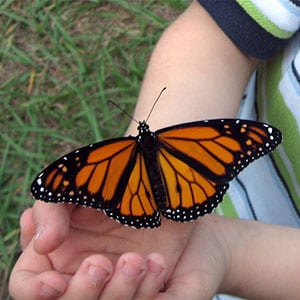
Lichterman Nature Center, Memphis — A lecture series about butterflies continues this month on March 28. For details, visit www.memphismuseums. org/li-event_program-15897.
Lichterman Nature Center
5992 Quince Road, Memphis, TN 38119
901-767-7322
Biennial Members Meeting of the North American Butterfly Association, Chattanooga — This year’s meeting will be held at the Chattanooga Marriott June 12-15. Visit naba.org/meeting.html for more information on what the event has to offer.
Butterfly counts — Numerous butterfly count events are held across the state throughout the year. A listing of dates and places can also be found at nabamidtn.org.
NABA chapters in Tennessee
NABA — Middle Tennessee
Rita Venable, president
Email: rita@godtheartist.com
Website: www.nabamidtn.org
NABA — Tennessee Valley
Bill Haley, president
215 McFarland Ave., Chattanooga, TN 37405
Phone: 800-262-0695, ext. 4056
Email: wgh@tnaqua.org
Website: tvcnaba.org



